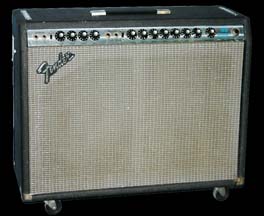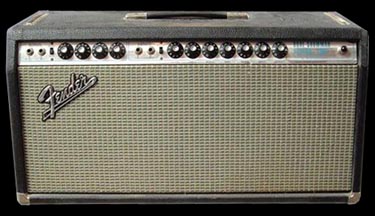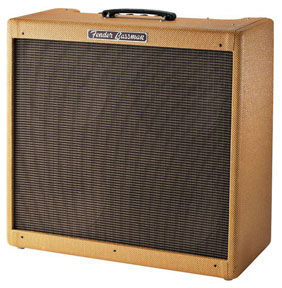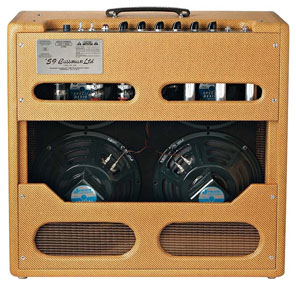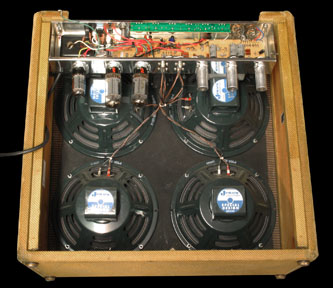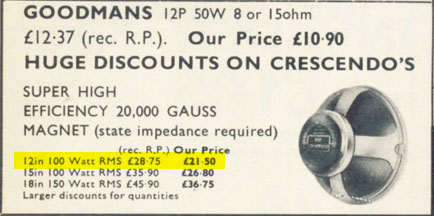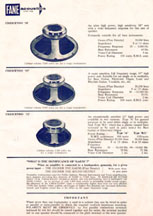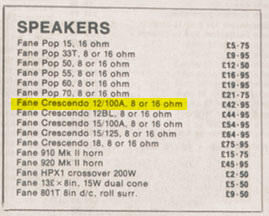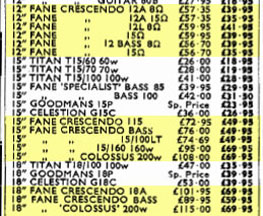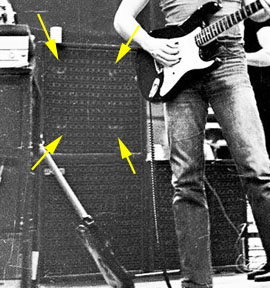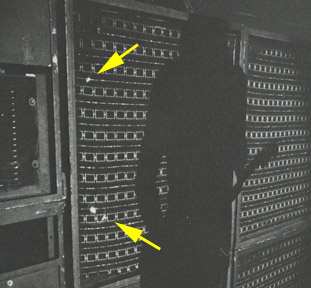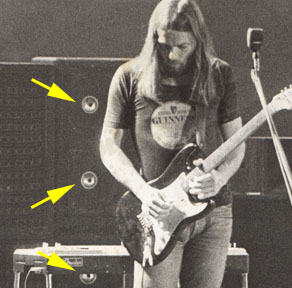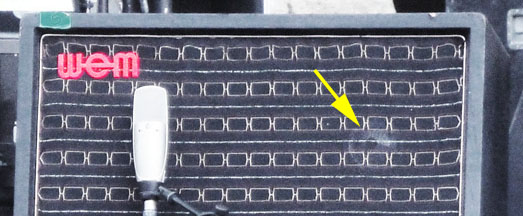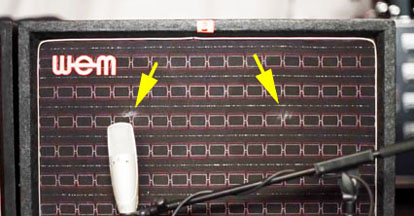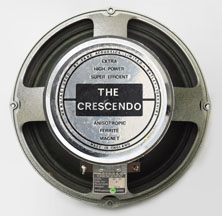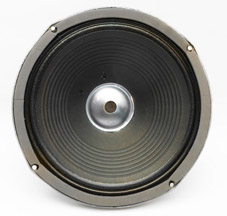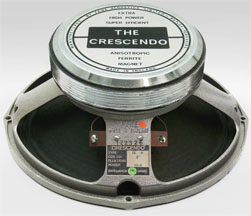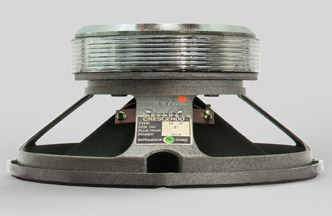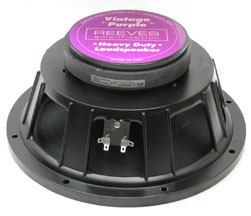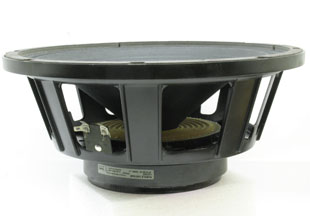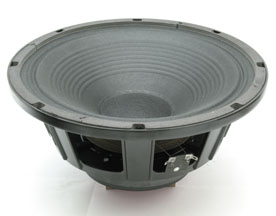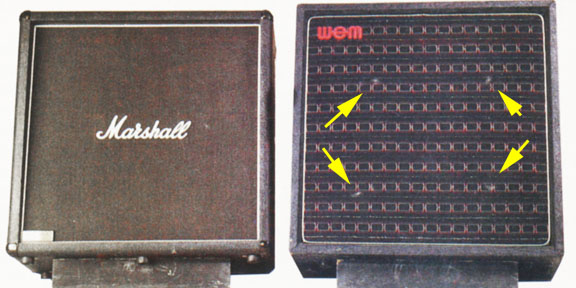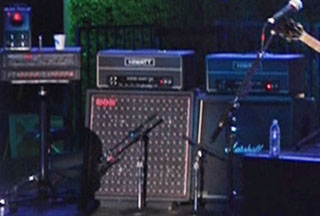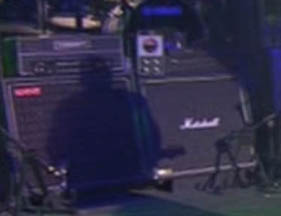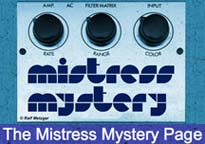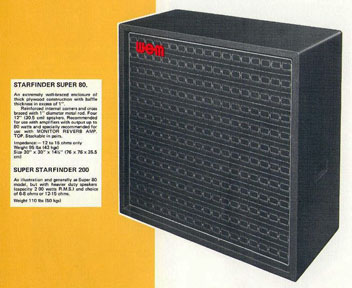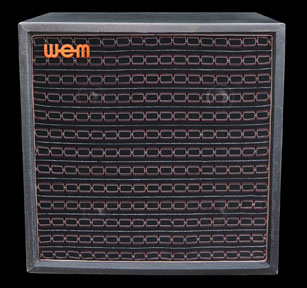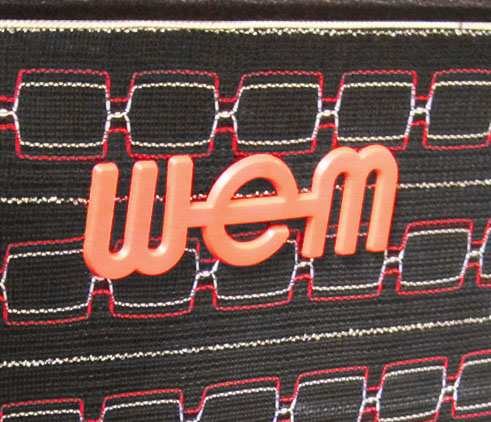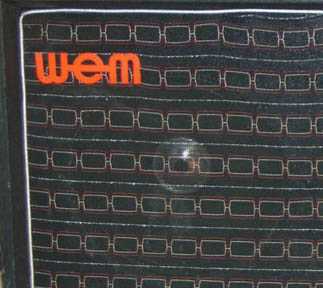NOTE: This website is frequently updated. Last update February 2022
WOT'S, UH THE DEAL WITH ALL THE DIFFERENT TWIN REVERBS? - There are numerous versions of the Twin Reverb that Fender has produced throughout the years. David used a silverface Twin Reverb in the Dark Side of the Moon recording sessions, and a Dual Showman Reverb (a Twin Reverb in head form) for the Wish You Were Here Sessions. He also briefly use a pair of silverface Twin Reverbs in a 1984 performance, and a pair of Twin Reverb II amp heads from 1984-87.
The Fender 65 Twin Reverb reissue (from 1992 onward) is the one I use for Pink Floyd's Dark Side of the Moon/Wish You Were Here album tones. The 65 reissue is basically the blackface/early silverface Twin Reverb circuit architecture with two 12" Jensen C12 speakers. It sounds very similar to the original amps, but speaker types make a big difference with the sound. The stock amp sounds excellent, but you can switch the Jensens for Weber 12F150's or Weber Californias if you want something closer to the sound of the old JBL speakers used in the original blackface and silverface Twins. However, the stock C12s in the TRRI sound really good (at least when I bought mine around 2006 they did) once they were completely broken in. They sound harsh for the first few weeks when new, as is the case with most new speakers. You can also upgrade the four stock 6L6 Groove Tubes (that's what was in mine, new) for a good set of NOS tubes or JJ Electronics tubes, and swap preamp tubes for NOS or JJ's (2-5 tubes depending on which input you use most and if you use the reverb or vib/trem). Different tubes offer different sound characteristics, which can affect the cleanness and EQ of the tone. Note that an amp tech will need to rebias the amp for you when you change tubes, for the best optimal sound.
Here is a clip using my Twin Reverb RI. This is a Strat with EMG-SA neck pickup, Boss CS-3 Compressor, and a ProCo Rat.
There were several amps made by Fender that were in the same tone family as the Twin Reverb - the Dual Showman Reverb, Quad Reverb, Super Six Reverb, and Vibrosonic Reverb. All used the exact same chassis, circuit, transformer, and tubes as the Twin Reverb. What is the difference between the old blackface and the silverface Twins? First, blackface and silverface simply refers to the color of the faceplate behind the knobs. 1963-67 blackface Twins and early silverface ('67-69) Twins are the same circuit as far as the sound produced, and most ideal for Gilmour tones. After '69 the silverface amps became slightly more bassy, with slightly less head room (less clean) when you turn them up, but still good amps for Gilmour. Around 1972 a master volume was added, but they were still basically the same design. In 1977 the circuit changed significantly to a very different sound, then came the Twin Reverb IIs in the 1980s and Red Knob Twins. The Twin Reverb II still retained the basic Fender clean tone. Any of those will work for the way Gilmour used the amp. Keep in mind that buying an old Twin Reverb may cost less than a brand new one, or cost about the same as a used '65 reissue, but the capacitors in those older amps can be 30-40+ years old. They should be replaced after about 20-25 years, which adds to the cost. The old tubes and speakers can also be worn out, which will add to the cost.
Fender silverface Twin Reverb amp, and Dual Showman Reverb amp.
The Showman was basically the head version of the Fender Twin Reverb, for use with and external speaker cabinet
David used a 1972-74 era Fender Dual Showman Reverb head with a matching Fender 2x15 inch speaker cabinet in the 1976 recording sessions for Pink Floyd's Wish You Were Here album, along with his Hiwatt/WEM cab, and a Leslie 760 rotary speaker cab. The Showman was basically the silverface Twin Reverb in a 100w head form.
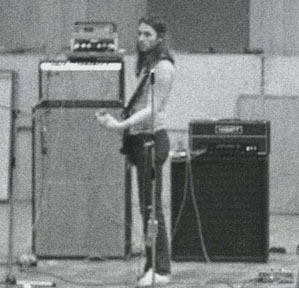
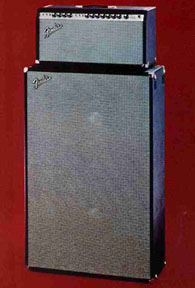
Gilmour recording at Abbey Road in 1975 using a 1972 Fender Dual Showman Reverb amp with matching Fender 2x15 cabinet with JBL speakers
and a Hiwatt Custom 100 through a WEM 4x12 cabinet with Fane Crescendo speakers
David also used the Twin Reverb/Showman preamp in his rigs, in the form of the Alembic F2-B. The Alembic was essentially two of those pre-amps in one rack housing. David used them on the front end of his Yamaha RA-200 rotary speaker cabinets for Pink Floyd's 1977 tour and 1980-81 performances of The Wall, and in his barn and Hove studios. He also used one in his 1990 Pink Floyd rig. In 1994 David had his Hiwatt preamps switchable, so they could be bypassed and allow the Alembic to become the preamp for his whole live Pink Floyd rig.
The Alembic F2-B preamp was essentially two Twin Reverb/Showman preamps in one rack enclosure
The modern Fender Twin Reverb works very well to replicate those many of the 1970s Pink Floyd tones heard on Dark Side of The Moon and Wish You Were Here. Just remember these are heavy, loud 85-100 watt amps. 100 watts is fine for live use in medium to large venues, but overkill for small venues or home use. For most people who will never be turning the volume up past 1 or 2 in the home, you would be much better off getting a smaller Fender amp with a single 12" speaker.
WOT'S, UH THE DEAL WITH THE FENDER 59 BASSMAN REISSUES DAVID GILMOUR USED?
There are many versions of the classic Fender Bassman amp combo, but the model that David is most known for using is the reissue from 1990 called the 59 Bassman. It is the perfect amp to use clean, with a B.K. Butler Tube Driver or Proco Rat. It also sounds incredibly good with a Big Muff, although there are no known recordings of David using one with a Bassman. He began using them around 1991 in his live rig and for session work like the La Carrera Panamericana soundtrack, and throughout the 1990s and early 2000s. He often used them in conjunction with Hiwatt SA212 combo amps with Fane Crescendo speakers, for a blend of the Fender and Hiwatt sound. The pedals he used in that rig were often a Rat, Boss CE-2 chorus and Boss CS-3 compressor. This Bassman/Hiwatt setup was used for most of the 1993 Pink Floyd sessions which resulted in the Division Bell album, where David first started using the B.K. Butler Tube Driver. David has also used other similar Fender tweed amps in his Medina studio in Hove, such as the Bandmaster and Tremolux.
Below are clips of my 59 Basman LTD with blue frame alnico speakers.
![]() Cluster One - with Fender 59 Bassman LTD - Strat with EMG-SA pickups
Cluster One - with Fender 59 Bassman LTD - Strat with EMG-SA pickups
![]() 5AM - with 59 Bassman LTD - Les Paul with P90 pickups
5AM - with 59 Bassman LTD - Les Paul with P90 pickups
![]() Purple Rain solo (Gilmour/Tom Jones version) - Proco RAT through 59 Bassman LTD - Strat with EMG SA pickups
Purple Rain solo (Gilmour/Tom Jones version) - Proco RAT through 59 Bassman LTD - Strat with EMG SA pickups
![]() Calling - B.K. Butler Tube Driver through 59 Bassman LTD - Strat with EMG-SA pickups
Calling - B.K. Butler Tube Driver through 59 Bassman LTD - Strat with EMG-SA pickups
![]() Hey Joe - B.K. Butler Tube Driver through 59 Bassman LTD - Strat with EMG-SA pickups
Hey Joe - B.K. Butler Tube Driver through 59 Bassman LTD - Strat with EMG-SA pickups
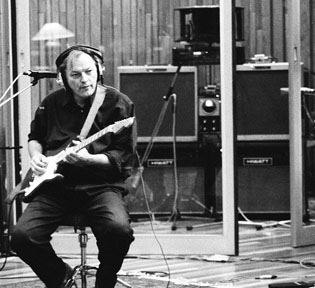
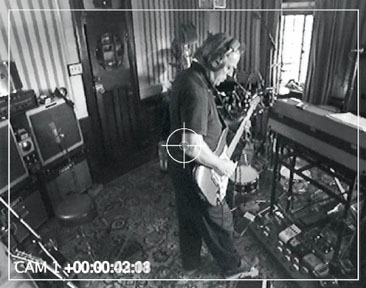
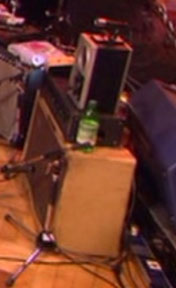
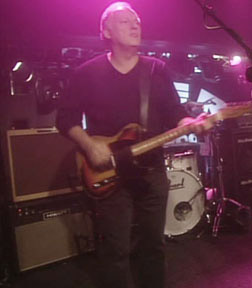
Gilmour's 59 Bassman reissues and Hiwatt SA212 stereo rig used for the 1993 Pink Floyd recording sessions (left) and later in 1999 and 2004 (right)
The '59 Bassman is a replica of the original 1959 tweed covered Bassman model 5F6-A combo, a 45w amp with four 10" speakers, and four inputs. The cabinet was made of plywood covered with plain tweed cloth, not laquered tweed like the originals. The original Bassmans had a tube rectifier, but the 59 Bassman reissue was built with a plug-in solid state rectifier. Many people replaced these (including Gilmour) with a real 5AR4/CV1377 rectifier tube. The control panel included a fake "ground" switch, to match the look of the original Bassmans. Since modern power cords include a ground prong, a ground switch on an amp is no longer necessary. The original 59 Bassmans were fitted with four 10", 8 ohm, 20w Legend 1028P blue frame Alnico speakers with paper voice coil formers, made by Eminence for Fender. A few years later these were changed to Jensen P10R speakers with kapton voice coils, which held up better to high volume than the paper coils in the Eminence speakers. The Eminence were slightly brighter and slightly dirtier at high volume. A photo from the Evidence Audio website of David Gilmour's 59 Bassman being serviced with new speaker wire confirmed the original blue frame alnicos are still in his.
Around 1995 the reissue was re-named '59 Bassman LTD (supposedly for laquered tweed) and several changes were made. Fender switched back to using a real tube rectifier, added a tinted laquer to the tweed covering, and changed the cabinet construction to finger jointed solid pine wood. It was still fitted with Jensen P10R speakers. The easisest way to tell an original 59 Bassman reissue from the later LTD is the fake "ground" switch on the original. It was removed for the LTD version.
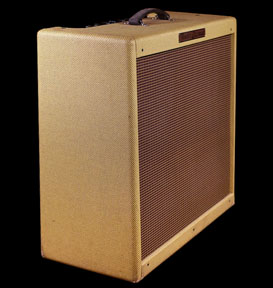
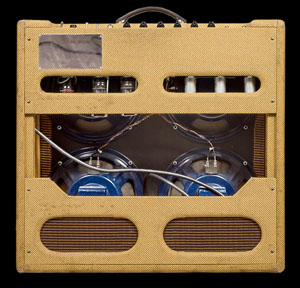
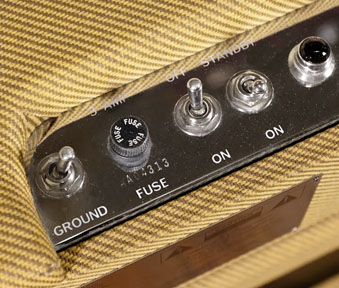
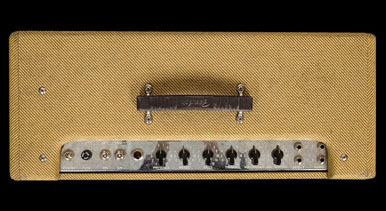
showan above - 59 Fender Bassman reissue from 1990 with blue frame alnico speakers made by Eminence.
Note the extra "ground" switch on the left, which was actually a dummy switch to mimic the look of the original Bassman.
shown above - 59 Fender Bassman LTD (laquered tweed) from 1995 with Jensen PR10 speakers
The normal channel on the 59 Bassman sounds very similar to the Twin Reverb/Showman when playing clean, but at high volume the Bassman sounds more compressed and breaks into overdrive. Vintage Bassman amps with the 5F6-A circuit sound very close to the 59 Bassman reissue with blue frame alnicos, but depending on the speakers used, they may sound more overdriven at high volume. The old Marshall JTM45 is also nearly an exact copy of the Bassman circuit, but substitues a 12AY7 preamp tube with a 12AX7 tube for more gain, which makes it a bit too dirty for most Gilmour tones. Same with the Marshall Bluesbreaker.
TYPES OF SPEAKERS - Speakers are just as important as the type of amplifier used, as they are the final voice the signal comes through. David's WEM speaker cabinets are typically loaded with Fane Crescendo 100w 12" speakers. They are a perfect speaker to blend with the Hiwatt sound, and out of all of David's gear, the Hiwatt/Crescendo combo could be said to define the core foundational tone heard in most Gilmour performances. The Crescendos have a distinct bright tone that accents the upper mid range. The sound is very detailed and cuts straight through in a band mix. The bright mid range is almost too bright with certain amps, like Marshalls, but works well with a Hiwatt and most Fender amps. It is perfect with mid-scooped pedals like the Big Muff and B.K. Butler Tube Driver.
"One of the first jobs I did in the band was to go out and buy him (Gilmour) some new Hiwatt amplifiers. I went down to Hi-Watt in Kingston (in 1974) and saw Dave Reeves and bought two 100 watt heads which are still in Dave's rack today. He had WEM 4x12 cabinets with Fane Crescendo speakers in, identical to the ones he uses now…" - Pink Floyd backline tech Phil Taylor, Guitarist Magazine Jan 1995
"I have two new 100-watt Fender Twin Reverb heads running to two 4xl2 cabinets each-two WEM cabinets with Fane Crescendo speakers and two Marshall cabinets with Celestions." - David Gilmour, Guitar Player, Nov 1984
Fane Crescendo speakers were made by the legendary British loudspeaker company Fane in the late 1960s, and throughout the 1970s and '80s. In the 1970s Fane made speakers for Selmer,Watkins (WEM), Simms-Watts, Vox, and Dave Reeves of Sound City and Hiwatt fame, which is likely where Pink Floyd was first introduced to them. Fane produced a massive number of speaker models with many different options, so there is not one "Fane" sound, and the Crescendos sounded very different to other Fanes. There were also several different Fane Crescendo models with various speaker frame designs and labels. The original Crescendos were 12" 100w, 15" 100w, and 18" 150w models, all available in both 8 ohm and 15-16ohm. Two common types of 12" Crescendos were made in the 1970s - type 'A' all-purpose speakers, with aluminum dust caps, and type 'B' and 'L', with plastic treated linen surrounds, which were sold in pairs and intended for bass guitar and organs. Those had a wider frequency range than the type 'A'. By the late 1970s there were at least 14 different models of Crescendo speakers offered by Fane.
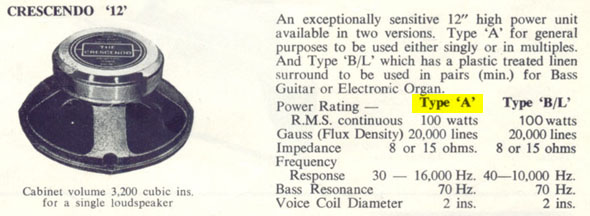
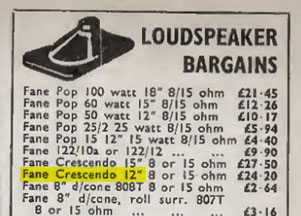
Shown above - Fane Crescendo speaker catalog pages and ad listings from the early 1970s.
Shown above - Practical Wireless catalog page from 1978 listing the wide variety of Crescendo speakers available
The type of 12" Crescendos David Gilmour has used since the early 1970s are type 'A', with the identification codes 122326 (8 ohms) and 122315 (16 ohms) ink stamped on the cast metal speaker frame. The 8 ohm 122326 were the more common than the 16 ohm. These had large ceramic (anisotrophic ferrite) magnets, 20,000 gauss flux density, 2" voice coils with fiberglass formers, and 3" diameter aluminum dust caps with a round, felt diffuser mounted in the center. Aluminum caps were popular with many speaker manufactureres in the 1970s. They allowed the high frequencies that are normally dampened with paper or cloth caps to be retained and radiated through the cap dome. This accented more of the upper mid range, adding a unique, jangly top end to the Crescendo sound. They brought out much more detail in the top end, but some found the sound too harsh. They work very well with the Hiwatt frequency range however. These silver dust caps can be seen through the grille cloth in David's 1994, 2006, and 2015/16 tour speaker cabinets.
It is not clear if David has always used type A Crescendos with silver dust caps, but they can be seen in several of his WEM cab photos from 1973 and 1974, so he has probably always used this speaker. Little is known about the speakers in David's combo amplifiers, but Phil Taylor revealed in an interview (Feb 2015 Guitarist Magzine) that David also uses Fane Crescendos in his Hiwatt SA212 combo studio amp. However, in April 2016 Phil told Calyton Calloway (of Hi-Tone amplification) that David has Fane 122231 speakers in his SA212, which are very different than the 122326/122315 Crescendos, with much more bass. While Phil certainly knows what speakers are in David's cabs and combos, David himself seems to have not been that familiar. In a 1979 interview conducted by David Rosen, Gilmour was asked what speakers were in his in the WEM cabs and David replied "I'm not too sure actually. Um…they are by Fane…I'm not too sure."
Shown above - David Gilmour's WEM Starfinder 4x12 speaker cabinets loaded with Fane Crescendo 100w speakers, from Pink Floyd's
1973 and 1974 tours. Note the aluminum dust caps indicate these are Crescendo 12 'A' type speakers.
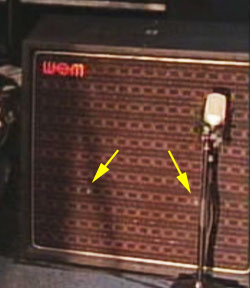
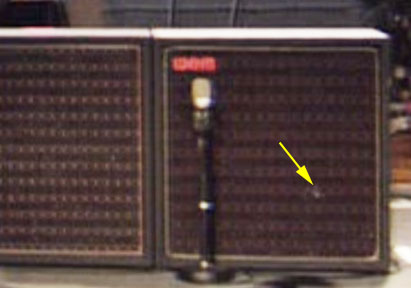
Shown above - David Gilmour's WEM Starfinder 4x12 speaker cabinets from his 2006 tour with barely visible
reflections from the aluminum dust caps from the Fane Crescendo 100w speakers.
Shown above - David Gilmour's WEM Starfinder 4x12 speaker cabinets loaded with Fane Crescendo 100w speakers, from his 2015 tour.
Note the aluminum dust caps visible through the grille cloth, indicating these are Crescendo 12 'A' type speakers.
Type A speakers were typically listed in speaker catalogs as "Crescendo 12A" and the spoke labels on the speakers identified them as type "12 A". I have also seen one catalog listing them as "Crescendo 100A", and a few with "100 'A' "on the spoke labels. The 15" Crescendos were also sometimes labeled "100A". The cast metal speaker frames had four spokes with a notch hole cut out of the bottom of each spoke around the mounting screw holes. Early model Crescendos had cast metal frames with plain spokes, and later "FANE MADE IN ENGLAND" was cast into one spoke. Frames were coated with a gray hammerite finish but changed to black in the late 1970s-early 1980s. I have read that production changed to pressed/formed steel frames at some point, but every Crescendo I have ever seen had a cast aluminum frame.
The paper indentification labels, usually printed in black/brown/red color, were placed on one spoke. The 122326 and 122315 ink stamped identification codes were usually stamped right above the label on the spoke. They had brown solder tags to connect the speaker wires, screwed to the spoke with flat head screws. Later 1970s and 1980s models changed to plastic push tags.
Crescendos are characterized by their massive ceramic speaker magnets with beveled edges around the back plate. The outer edge of the magnet was wrapped with a ribbed silver foil sticker tape. The silver foil Crescendo label on the back plate was made in two versions - a Black Label and Silver Label. The Black Label had all black printing so the text was in silver on black. The Silver Label version was reversed so all the text was in black, other than The Crescendo name. Fane also sold the exact Crescendo 12A speaker with a regular Fane label.
The speaker cones were ink stamped with an identification code, although many only had a partial stamp because of the curved cone shape. The ink stamps on the cones of my speakers are marked 1021/15, but I have seen other Crescendo cones with completely different numbers. Fane used Kurt Mueller speaker cones in the beginning, then changed to Pulsonic cones, then back to Kurt Mueller in the early to mid 1970s.
Shown above - One of my Fane Crescendo 100w 12 A speakers from 1976 or 1977 with 122326 ID code. The 12 A was the type often used by Gilmour.
The massive magnet and ribbed foil tape make them easy to identify. Also note the notches around the mounting screw holes that cut through the frame spokes.
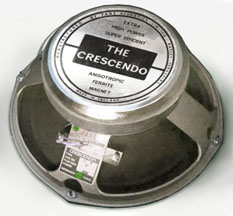
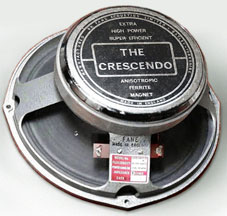
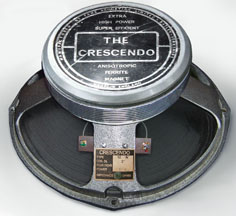
Shown above - Fane Crescendo 100w 12 A speakers from the early and mid 1970s with 122326 ID codes (8 ohm) and various spoke label colors.
All had aluminum dust caps
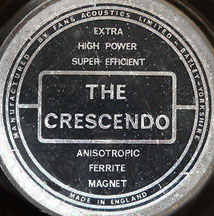
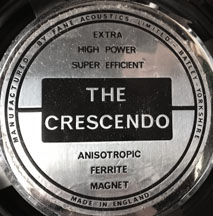
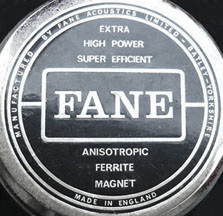
Shown above - Three types of cap labels uses on 1970s Fane Crescendos, a black, silver, and a standard
Fane label that was also used on some speakers with the exact same specs as the Crescendo 12 A.
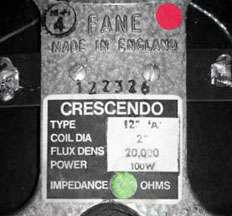
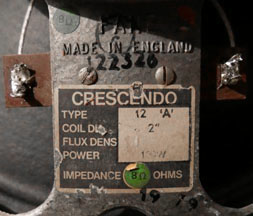
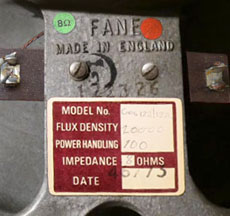
Shown above - Examples of frame spoke labels used on 8 ohm Fane Crescendos from the 1970s. Note the 122326 ID codes.
Also note the words "FANE MADE IN ENGLAND" cast into the spokes of early Crescendo frames.
Fane branded their stock speakers for Hiwatt, Sound City, and Simms-Watts, but they were usually marked with the same speaker model numbers as the Fane branded versions. I have seen many examples of Fanes with those brand labels on the exact same cast metal frame as the Crescendo, but they were not Crescendos. Most were 50w or 70w Fanes with completely different specs. There is a 4ohm Crescendo with the model number 122346, but the specs and sound are different from the type Gilmour used. Fane also made numerous high powered PA speakers using the Crescendo name that people try to pass off as the type Gilmour used. Some of them can be used as guitar speakers, but they were nothing like the old Crescendo 12A speakers. There was a 200w and 400w bass woofer version with a 4" voice coil called a Crescendo Colossus. There was a 1980s era Crescendos labeled "12E" with black coated frames and push tags, in both 120w four spoke frames and 180w eight spoke frames. The 300w Fane Crescendo 12MB was another HiFi studio/PA speaker. The MB means it's a mid bass driver, like the type used in two-way ported enclosures with a horn tweeter. There were also 12" and 15" "Crescendo M.V." speakers, and Crescendo 15B and 18B PA speakers, all of which have completely different specs and sound than the 12A.
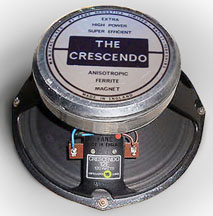
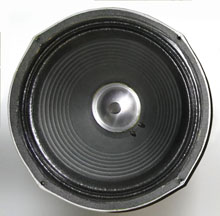
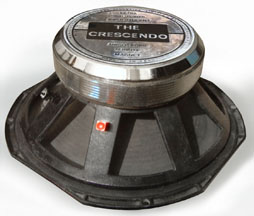
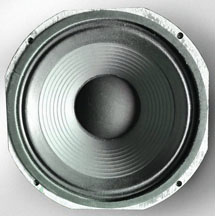
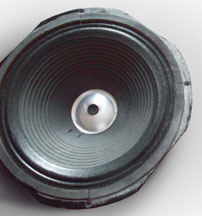
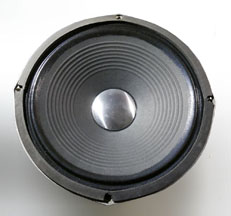
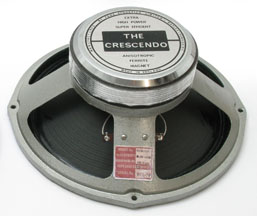
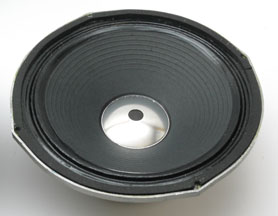
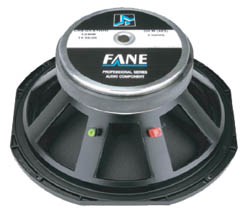
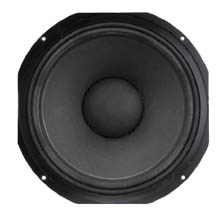
Shown above - There were various other versions of Crescendo speakers with different specs, differing 4 and 8 spoke cast metal
frame designs, and differing cloth or aluminum dust cap designs. Many of these were PA speakers and none are the type Gilmour used.
(top row) 1980s Crescendo 12 'E' and 15 'E' PA speakers and cones
(bottom left to right) 1983 Crescendo 12 'E' speaker cone, 1977 12 A speaker cone, and 100A speaker and cone.
(bottom row) mid 2000s Crescendo 12MB 300w PA speaker and cone
The current Fane Acoustics company no longer makes Crescendos and vintage Crescendos in good condition are very difficult to find today, expensive when you can find them, and can sound very different from one another due to age and use. It is also sometimes difficult to identify real Crescendos. The same cast metal Fane frame used for the Crescendo was also used for other speakers with various wattages, magnet sizes, speaker cone types, and voice coils. Without seeing the model number or specs it can be very difficult to identify which is which because Crescendos were not always branded with a Crescendo label. I have also seen several counterfeit Crescendos. These are are sometimes Fane-made Sound City and Hiwatt speakers that use the exact same frame as the Crescendo with fake Crescendo and ID labels applied to them. I have also seen different model Fane speakers that have been re-labeled with fake Crescendo labels. These are typically 50w or 70w Fane speakers with completely different specs and sound than the Crescendo.
SPEAKER COMPARISONS - I have listed as much information above as I can for those of you that want to seek out the original 12 A Crescendos, but there are two good modern speakers that do a good job replicating the Crescendo tone, and several other alternative speakers listed below. For comparison purposes, below are sound clips of a real Fane Crescendo 12A through a Hiwatt (Reeves Custom 50). Each performance was recorded on a Boss RC-3 looper and played back through my rig with identical effects and settings, so each performance is identical. The amp was set at very high volume, not bedroom volume. Each speaker was mounted in the same isolated 1x12 speaker cab and recorded with a Sure SM57. The microphone was placed on each speaker to get something that sounded like what I hear in the studio. Keep in mind that this is just one Crescendo, and not all Crescendos will sound identical.
![]() Fane Crescendo Type A speaker with Green Russian Big Muff - On the Turning Away solo
Fane Crescendo Type A speaker with Green Russian Big Muff - On the Turning Away solo
![]() Fane Crescendo Type A speaker with a Green Russian Big Muff - In Any Tongue solo - no modulation
Fane Crescendo Type A speaker with a Green Russian Big Muff - In Any Tongue solo - no modulation
![]() Fane Crescendo Type A speaker with a Green Russian Big Muff - In Any Tongue solo with modulation
Fane Crescendo Type A speaker with a Green Russian Big Muff - In Any Tongue solo with modulation
![]() Fane Crescendo Type A speaker with EHX Ram's Head Big Muff - Mother solo
Fane Crescendo Type A speaker with EHX Ram's Head Big Muff - Mother solo
![]() Fane Crescendo Type A speaker with Green Russian Big Muff - Money solo
Fane Crescendo Type A speaker with Green Russian Big Muff - Money solo
![]() Fane Crescendo Type A speaker with B.K. Butler Tube Driver - Take A Breath solo
Fane Crescendo Type A speaker with B.K. Butler Tube Driver - Take A Breath solo
![]() Fane Crescendo Type A speaker - clean tone with compressor - Coming Back to Life solo
Fane Crescendo Type A speaker - clean tone with compressor - Coming Back to Life solo
![]() Fane Crescendo Type A speaker - clean rhythm tone with compressor - Another Brick in the Wall Part II
Fane Crescendo Type A speaker - clean rhythm tone with compressor - Another Brick in the Wall Part II
This is a comparison of one of my original Fane Crescendo speakers to the Rawson Sparfield Starfinder and Hi-Tone Crescendo A speakers.
These are the same sound clips from this page. Thanks to HITUBE Amps & Fx
for putting this video together.
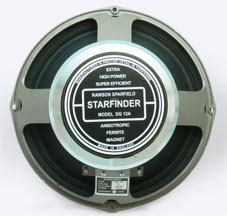
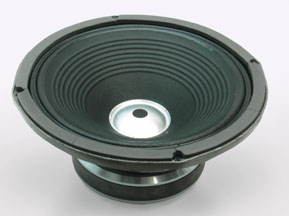
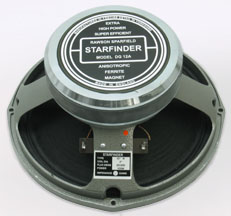
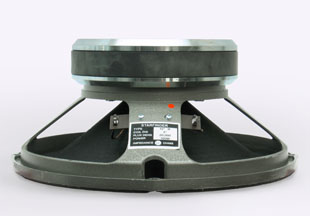
Shown above - 100w Starfinder with aluminum dust cap from Rawson Sparfield, made in the United kingdom
Rawson Sparfield sells a 100w Fane Crescendo 12A replica that is a very accurate recreation of the original, using a similar cast metal frame, the same magnet and voice coil specifications, and aluminum dust cap just like the original. It is named the Starfinder, after the name of the WEM Starfinder speaker cabinets that Gilmour is so much associated with, and the company is named after Rawson Sparfield Ltd, the original builder of those Starfinder cabs, although RS is not affiliated with either original company. RS is run by Jeff Lewis, head of the U.K. amplifiers and speaker cabinet company Matamp, and Chris Hewitt, owner of Ozit Morpheus Records and CH Vintage Audio. Chris is a music gear collector with a large collection of vintage WEM audio equipment, including one of Pink Floyd's early mixing boards bult by WEM.
The Starfinder is made in the U.K. using Kurt Mueller cones and the magnets are charged on a magnetizer used by the original Fane speaker company. Visually the speaker looks very similar to the original Fane Crescendo, but the spoke holes in the cast metal frame are not as wide, the underside of the magnet has a beleveled edge rather than a corner like the original, and the hammerite finish pattern is smaller and smoother looking. RS sells the speakers individually, and also loaded in their Starfinder 4x12 speaker cabinet, which is a replica of the WEM Super Starfinder 200 4x12 cabinets that David Gilmour used. Hearing a Hiwatt through the Starfinder speaker is instantly recognizable as the Gilmour Pink Floyd sound, especially his early to mid 1970s tones. All Crescendos do not sound identical, but compared to my originals, the Starfinder is slightly darker with less upper mid range. It is still very close, as you can hear in the sound clips below. Compare these to the original Fane Crescendo clips at the beginning of this section.
![]() Starfinder speaker with Green Russian Big Muff - On the Turning Away solo
Starfinder speaker with Green Russian Big Muff - On the Turning Away solo
![]() Starfinder speaker with Green Russian Big Muff - In any Tongue solo - no modulation
Starfinder speaker with Green Russian Big Muff - In any Tongue solo - no modulation
![]() Starfinder speaker with Green Russian Big Muff - In any Tongue solo with modulation
Starfinder speaker with Green Russian Big Muff - In any Tongue solo with modulation
![]() Starfinder speaker with EHX Ram's Head Big Muff - Mother solo
Starfinder speaker with EHX Ram's Head Big Muff - Mother solo
![]() Starfinder speaker with Green Russian Big Muff - Money solo
Starfinder speaker with Green Russian Big Muff - Money solo
![]() Starfinder speaker with B.K. Butler Tube Driver - Take A Breath solo
Starfinder speaker with B.K. Butler Tube Driver - Take A Breath solo
![]() Starfinder speaker - clean tone with compressor - Coming Back to Life solo
Starfinder speaker - clean tone with compressor - Coming Back to Life solo
![]() Starfinder speaker - clean rhythm tone with compressor - Another Brick in the Wall Part II
Starfinder speaker - clean rhythm tone with compressor - Another Brick in the Wall Part II
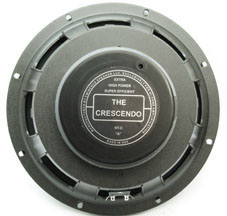
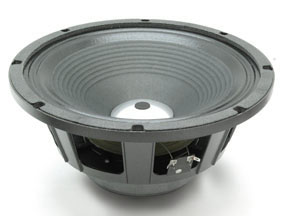
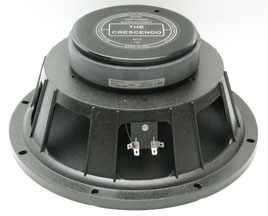

Shown above - 150w Hi-Tone Crescendo 'A' with aluminum dust cap and Kurt Mueller cone. Made for Hi-Tone by Eminence
Hi-Tone Amplification sells a 150w Fane Crescendo replica called the Crescendo 'A', made by Eminence. Although not an exact copy, it is very close to the sound of a 1970s Fane Crescendo and includes the aluminum dust cap. These are made with a replica of a German-made Kurt Mueller cone, the same type that was used in original 1970s Fane Crescendos. These are typically sold with Hi-Tone Eclipse 2x12 and 4x12 cabinets, but they can sometimes also be bought in the replacement speakers section on the Hi-Tone site.
The first time I heard these through a Hiwatt I instantly recognized the Gilmour sound. Compared to my original Crescendos, the Crescendo A is slightly brighter, with slightly more treble/upper mids, and slightly less low end. It is still very close to the original, as you can hear in the sound clips below. Compare these to the original Fane Crescendo sound clips at the beginning of this section. If you want the Delicate Sound of Thunder / Pulse era sound through a Hiwatt, pair the Crescendo A with a Celestion G12T-75 speaker in your cabinet. That particular Celestion, especially those made in the mid 1990s - adds a thicker mid scooped tone with lots of low end to the bright mid range of the Crescendos to create a much richer and fuller tone. It also works for David's 2006 tour tones, heard on Remember That Night and Live in Gdansk.
![]() Hi-Tone Crescendo A speaker with Green Russian Big Muff - On the Turning Away solo
Hi-Tone Crescendo A speaker with Green Russian Big Muff - On the Turning Away solo
![]() Hi-Tone Crescendo A speaker with a Green Russian Big Muff - In Any Tongue solo - no modulation
Hi-Tone Crescendo A speaker with a Green Russian Big Muff - In Any Tongue solo - no modulation
![]() Hi-Tone Crescendo A speaker with Green Russian Big Muff - In any Tongue solo with modulation
Hi-Tone Crescendo A speaker with Green Russian Big Muff - In any Tongue solo with modulation
![]() Hi-Tone Crescendo A speaker with EHX Ram's Head Big Muff - Mother solo
Hi-Tone Crescendo A speaker with EHX Ram's Head Big Muff - Mother solo
![]() Hi-Tone Crescendo A speaker with Green Russian Big Muff - Money solo
Hi-Tone Crescendo A speaker with Green Russian Big Muff - Money solo
![]() Hi-Tone Crescendo A speaker with BKB 911 Tube Driver - Take A Breath solo
Hi-Tone Crescendo A speaker with BKB 911 Tube Driver - Take A Breath solo
![]() Hi-Tone Crescendo A speaker with a BKB 911 Tube Driver - Louder than Words solo
Hi-Tone Crescendo A speaker with a BKB 911 Tube Driver - Louder than Words solo
![]() Hi-Tone Crescendo A speaker - clean tone with compressor - Coming Back to Life
Hi-Tone Crescendo A speaker - clean tone with compressor - Coming Back to Life
![]() Hi-Tone Crescendo A speaker - clean rhythm tone with compressor - Another Brick in the Wall Part I
Hi-Tone Crescendo A speaker - clean rhythm tone with compressor - Another Brick in the Wall Part I
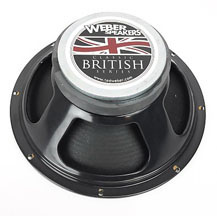
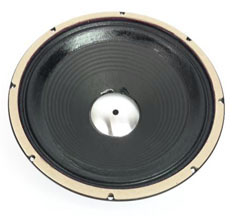
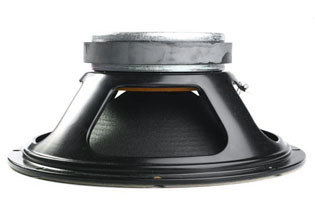
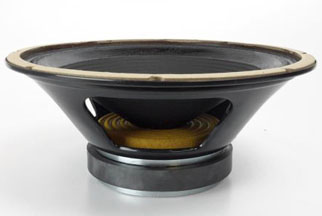
Shown above - 100w FC12 ceramic with aluminum dust cap from Ted Weber. Not exactly the Crescendo sound, but in the same family
Ted Weber FC12 100w ceramic speakers with aluminum dust covers are described as having the "Classic British Fane Crescendo tone". The FC in the name stands for Fane Crescendo, and they include the silver dust cap like the original Crescendo, but they really do not sound like a Crescendo. Similar tone family, but more of a distant relative, and more balanced for a wider variety of music. They do not have the same range in the highs and have a darker, fatter sound compared to the Fane Crescendo, but work well with a Hiwatt for Gilmour tones. They are also available with Alnico magnets.
![]() Weber FC12 speaker with a Green Russian Big Muff - In Any Tongue solo
Weber FC12 speaker with a Green Russian Big Muff - In Any Tongue solo
![]() Weber FC12 speaker with a BKB 911 Tube Driver - Louder than Words solo
Weber FC12 speaker with a BKB 911 Tube Driver - Louder than Words solo
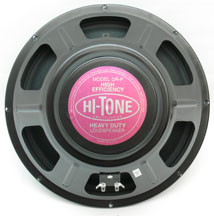
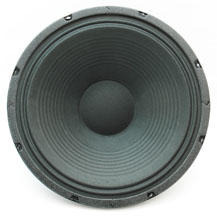
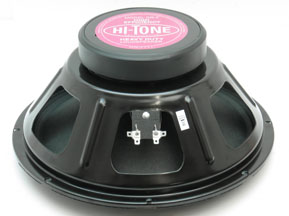
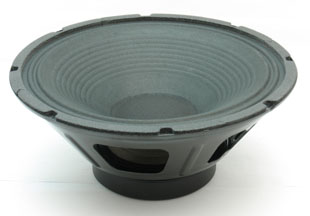
Shown above - Hi-Tone 75w DR-F speaker made by Eminence, based on a Fane purple backed speaker from the 1970s
The Hi-Tone DR-F 75w speakers are another good option for those who find thier Crescendo A speakers to be too bright. DR-Fs, which stand for "Dave Reeves Fanes", are based on the Fane 125161 purple backed speakers used in vintage Hiwatt cabs from the late 1970s. These are also bright speakers, but are more balanced for a wider variety of music and have less upper mids and more lower mids than the Crescendo A. They work well with a Hiwatt for Gilmour tones.
![]() Hi-Tone DR-F speaker with a Green Russian Big Muff - In Any Tongue solo
Hi-Tone DR-F speaker with a Green Russian Big Muff - In Any Tongue solo
![]() Hi-Tone DR-F speaker with a BKB 911 Tube Driver - Louder than Words solo
Hi-Tone DR-F speaker with a BKB 911 Tube Driver - Louder than Words solo
Reeves original 75w Vintage Purple speaker made by Eminence, based on Fane purple backed speakers from the 1970s
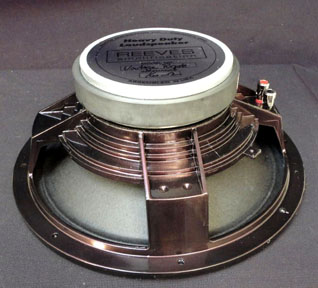
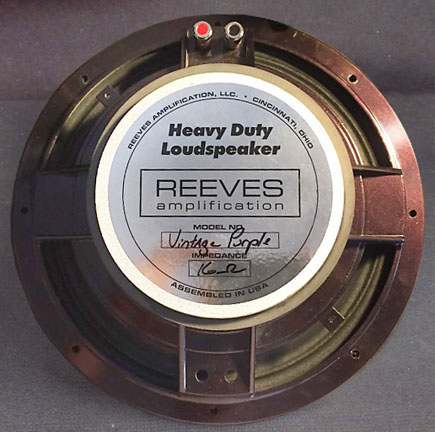
Reeves later 75w Vintage Purple speakers made by WGS, also based on Fane Vintage Purple speakers
Reeves Amplification also produce some excellent 2x12 and 4x12 speaker cabinets fitted with Vintage Purple 75w speakers made by Eminence. Like the Hi-Tone DR-F speakers, these are also based on one of the many Fane purple-backed speakers that were included in 1970s Hiwatt cabs. The type I have (with purple label, shown above) were based on the Fane 122293 model. They sound similar to the Hi-Tone Crescendo A speakers, but not as bright. The tone falls somewhere in between the Crescendo A and Weber FC12. They have a great Gilmour sound to them when paired with a Hiwatt amp and blend very well with mid 1990s Celestion G12T-75 speakers. Those were discontinued sometime around 2012-13 and replaced with Vintage Purple speakers built by Warehouse Guitar Speakers. They have the same cast metal frame as the Scholz Classic/Scholz Sugarcone speakers George Scholz used to sell with his Harry Joyce branded Hiwatt amps and speaker cabs. Reeves claims they sound very similar to the original Purples, but I have never tried them. They can be purchsed in speaker cabinets or individually here.
![]() Reeves Vintage Purple speaker with a Green Russian Big Muff - In Any Tongue solo
Reeves Vintage Purple speaker with a Green Russian Big Muff - In Any Tongue solo
![]() Reeves Vintage Purple speaker with a BKB 911 Tube Driver - Louder than Words solo
Reeves Vintage Purple speaker with a BKB 911 Tube Driver - Louder than Words solo
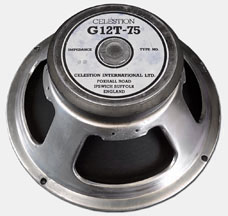
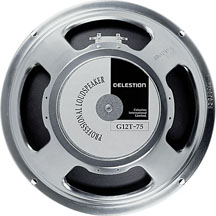
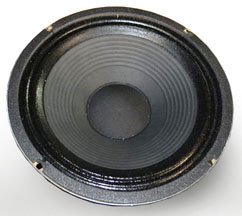
G12T-75 speakers with vent hole on back made by Celestion in England in the 1980s (left) and the version without the vent hole from the 1990s (middle and right)
The Celestion G12T-75 is another 75w speaker that sounds good with Hiwatt style amplifiers, but the sound has changed over the years. T-75s were first made in 1984 and are the most common type of Celestion speaker, so they are very easy to find. Originally the G12/75 and G12T-75 had a vent hole on the back to relieve VC pressure and tame the high end, allowing them to stay clean at very high volume, but later G12T-75 speakers from around 1986 onward had no vent. Originally the UK made T-75s were brighter sounding, but around 1995 Celestion changed the voicing to a darker sound, with much more mid scoop and low end. Around 2002-2003 production moved to China and the sound changed again, to something in between the 1980s sound and the more mid scooped 1990s sound. G12T-75 speakers from the 1980s and 1990s were made in England and say Made in England or Ipswitch England on the round magnet label. Those can be identified by the ink stamped date code on the frame spoke. Production made after 2002-2003 in China do not have the ink stamp, they have a white rectangular label on the side of the magnet.
I use a set from 1995 and the mid-scooped tone is almost the opposite of the Crescendo, but paired with a Hiwatt it has a very Gilmour-like sound. The tone is fatter and more mid-scooped than a Crescendo, with tight highs and a modest low end. It is a much darker sound than the other speakers listed above, and may not jump out as well in a band mix, but it still works well for gilmour tones. I use it to pair with brighter speakers like the Hi-Tone Crescendo A, DR-F, or the Weber FC12.
![]() Celestion G12T-75 speaker with a Green Russian Big Muff - In Any Tongue solo
Celestion G12T-75 speaker with a Green Russian Big Muff - In Any Tongue solo
![]() Celestion G12T-75 speaker with a BKB 911 Tube Driver - Louder than Words solo
Celestion G12T-75 speaker with a BKB 911 Tube Driver - Louder than Words solo
The Eminence Tonker and Tonkerlite speakers were rumored to be Crescendo clones. I never tried the standard Tonker, but I tried the Tonkerlite, which was supposed to be the closer of the two. They may sound similar to some model of Fane speaker, but nothing like the Crescendo to my ears. The Tonker Lite reminded me more of the Vintage Purple Fane sound.
FENDER SPEAKERS - David used a 1972-74 era Fender Dual Showman Reverb head with a matching Fender 2x15 inch speaker cabinet in the 1976 recording sessions for Pink Floyd's Wish You Were Here album, along with his Hiwatt/WEM cab, and a Leslie 760 rotary speaker cab. The Showman was sold with a matching speaker cabinet fitted with JBL D-130F 15" speakers with silver dust caps or optional D-140F 15" bass speakers. People sometimes mixed the two, but guitarists typically used the 130 speakers. It is unknown what David's used.
The 1990 tweed Fender 59 Bassman RI combo amps David used throughout the 1990s and early 2000s were fitted fitted with four 10", 8 ohm, 20w Legend 1028P blue frame Alnico speakers with paper voice coil formers, made by Eminence for Fender. The later 59 Bassman LTDs from 2000 onward changed to Jensen P10R speakers with kapton voice coils, which sounded similar, and could handle high volume much better. I have both and prefer the sound of the blue frame Alnicos. They are slightly more compressed and have a creamier, warmer, and cleaner sound than the Jensens to my ears.
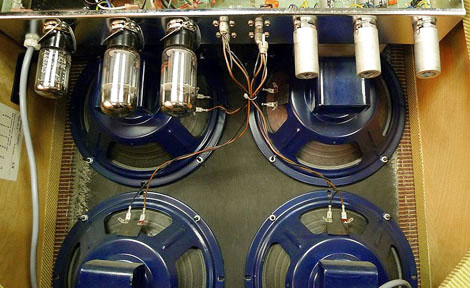
Gilmour's 1990-91 era 59 Bassman reissue with 10" blue frame Alnico Legend 1028P speakers (Evidence Audio photo)
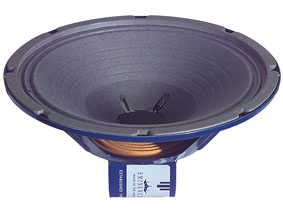
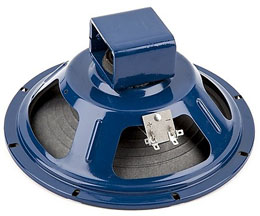
10" blue frame Alnico Legend 1028P speakers with paper voice coils, made by Eminence for Fender
Unfortunately, there was no consumer version of the original 1028P speaker offered by Eminence, but at the time I wrote this, Eminence was still making them exclusively for Fender to sell as replacements on their website, and through the Fender Custom Shop, although somewhat expensive. Fender says they are 30w, but they are actually the same 20w Legend 1028P blue frame Alnicos found in the original Bassman RIs. An alternative is the Eminence GA10-SC59 speakers, which are also 20w and with paper voice coil formers like the 1028P. Another option is the less expensive 1028K version that is readily available. The difference is the K has a kapton voice coil instead of paper, and is 35 watts instead of 20. It's a bit brighter and bassier than the 1028P according to Eminence, but not really any better sounding than the stock Jensen speakers already in the Bassman RI.
BLENDING CRESCENDOS WITH CELESTIONS - David nearly always runs at least two amplifiers at once in his live rigs, each going to its own speaker cabinet with its own type of speakers. Both amps are alwasy on, which allows him to have a blend of both types of speaker tones. In 1984, 1986, 1994, 2001- 2006, and 2015-2016 David combined cabs with Fane Crescendo speakers and separate cabs with Celestion speakers. This made a more balanced sound in his live rigs. Sometimes the Celestions were loaded in Marshall JCM-800 4x12"speaker cabinets, like in 1994 and 2001-2005, and sometimes in his WEM cabinets, like in 2006 and 2015.
![]() Hiwatt (Reeves Custom 50) through Hi-Tone Crescendo A and Celestion G12T-75 speakers with a BKB 911 Tube Driver - Louder Than Words solo
Hiwatt (Reeves Custom 50) through Hi-Tone Crescendo A and Celestion G12T-75 speakers with a BKB 911 Tube Driver - Louder Than Words solo
![]() Hiwatt (Reeves Custom 50) through Hi-Tone Crescendo A and Celestion G12T-75 speakers with a Ram's Head Big Muff - Mother solo
Hiwatt (Reeves Custom 50) through Hi-Tone Crescendo A and Celestion G12T-75 speakers with a Ram's Head Big Muff - Mother solo
![]() Hiwatt (Reeves Custom 50) through Hi-Tone Crescendo A and Celestion G12T-75 speakers with a Ram's Head Big Muff - In Any Tongue solo
Hiwatt (Reeves Custom 50) through Hi-Tone Crescendo A and Celestion G12T-75 speakers with a Ram's Head Big Muff - In Any Tongue solo
![]() Same as above, but with a Green Russian Big Muff - In Any Tongue solo
Same as above, but with a Green Russian Big Muff - In Any Tongue solo
![]() Same as above, but with a BKB/Chandler Tube Driver - In Any Tongue solo
Same as above, but with a BKB/Chandler Tube Driver - In Any Tongue solo
The type of Celestions David used have rarely been identified. The stock Marshall cabinets were sold with several different speakers types at different times: G12/75, G12-80, G12M-70, G12-100, G12H-100, G12-65 (1978-1983), G12T-75 (1984 - 1990). For David's 2006 tour he had three WEM Super Starfinder 4x12" cabs. One was loaded with Fane Crescendos and another was loaded with Celestion 75s, according to Analogman. Those were used with his Hiwatts, and I presume the third was a spare. Those Celestion 75s were either Rola Celestion G12/75, introduced in the 1970s, or the later G12T-75 version made in England in the 1980s - 1990s. I doubt he has used the China made version that started production around 2002-2003. In some ways the 75 sound is the opposite of the Fane Crescendo, which is why they balance so well with them.
"His stage speaker system consists of two WEM 4x12's with Fane Crescendo speakers, two Marshall 4x12's and three custom-made rotating speaker cabinets we call "doppolas." - Phil Taylor, Guitar World Sept 1994
"I've got three normal Hiwatt heads, AP100s…One Hiwatt powers a WEM 4x12 with the Fane Crescendos in it and a Marshall with Celestions; the second does the same thing but it has a chorused version of the first signal‚ in effect, this means that one pair has a wet signal and the other remains dry." - Phil Taylor, Guitarist Magazine Jan 1995
"David is using a pair (and one extra) Hiwatt DR 103 amp heads. They are his original 1974 Hiwatts, with OLD tubes. He is running them through WEM 4x12 cabinets with Fane Crescendo speakers in one and the other has celestion 75s" - Analogman, from his visit with Phil Taylor back stage in 2006
David also miced Crescendo cabs and Celestion cabs again in his 2005 Live 8 rig. Gilmourish.com lists those Crescendos as G12M, but I am not sure where he got that information. David used the Crescendos/Celestion mix again for his 2015-2016 tour. According to Phil Taylor, one WEM 4x12 cab was loaded with Crescendos and used with his DR504 Hiwatt, and one was loaded Celestion G12-100 speakers for use with his Alessandro amp. G12-100 (T3058, 15ohm) were made in the Rola Celestion period. The modern version of that speaker is the G12H-100. David had a third WEM loaded with Crescendos behind him as a spare that was used to monitor his second guitarist in the first part of the 2016 tour.
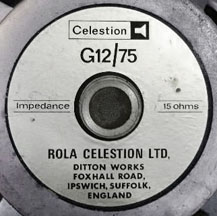
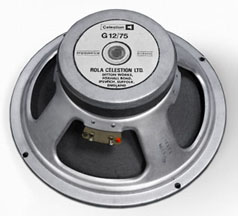
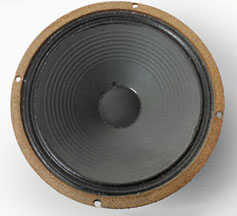

Shown above - Rola Celestion G12/75 from 1976 and the Celestion G12T-75 from 1984, both made in England
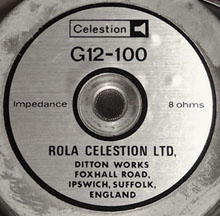
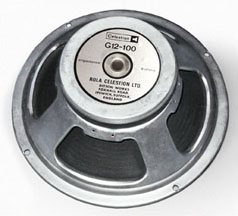
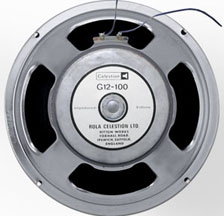
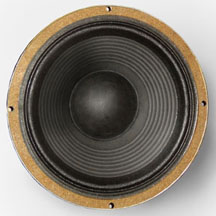
Shown above - Rola Celestion G12-100 from 1982, made in England
For those of you wanting this sound in a single 4x12 cabinet, you can load two Celestions and two Crescendos in an X pattern. I have been doing this for many years, and that is my preferred speaker cabinet with a Hiwatt for Gilmour tones. I have also tried the Crescendos on top and Celstions on bottom. I prefer the X pattern in my Hi-Tone Eclipse cab. The Celestions side-by-side made the overall sound a bit too bassy. Not in a bad way, but I thought thought the highs and mids came through better in the X pattern.
You can also use one Celestion and one Crescendo in a 2x12 cabinet, but keep in mind that 2x12s have have more highs and less lows and lower mids than 4x12s due to the way the different sound frequencies sum or cancel when they cross over coming out of the speaker cones. It will not result in a sound that is as full as using two of each speaker type in a 4x12
If you just want one speaker that blends both the bright mid range Crescendo tone and the darker, mid-scooped Celestion tone through a Hiwatt, you can try the Weber British Series ceramic FC12F speakers. I have them in a 2x12 cab and they sound somewhat similar to the blend of Crescendos and Celestions I have in one of my 4x12 cabs, although you definitely do not get the full tone spectrum of both speakers.
David Gilmour's Marshall JCM-800 speaker cab loaded with Celestion speakers and his WEM 4x12 cab loaded with Fane Crescendo 100w speakers,
from 1994. Note the aluminum dust caps visible through the grille cloth, indicating these are Crescendo 12 'A' type speakers.
David Gilmour's WEM 4x12 cabinet loaded with Fane Crescendo 100w speakers and Marshall JCM-800
speaker cab loaded with Celestion speakers from 2001 (left) and 2004 (right)
TYPES OF SPEAKER CABINETS - There are many good brands of speaker cabinets - Marshall, Fender, Mesa, Hiwatt, Hi-Tone, Reeves, Peavy, Bogner, Orange, et cetera. The type of wood the cab is made of makes little difference to the sound. You could make a cab out of baltic birch plywood, particle board, or even dense styrofoam. As long as the cab dimensions inside and the speakers are the same, they will sound practically identical. Plywood or solid wood cabs are going to be sturdier and last longer than particle board if they get hauled around a lot. In general, as long as it is a sturdy, well built cabinet, I don't think it matters what the brand or material is. The important factors regarding the sound are the size of the cab, the number of speakers, and if it is open or closed back.
• The size of the cabinet affects the tone. A large cab with a single speaker will have a fuller sound and more low end than a small cab with the exact same speaker, especially if it is a closed back cab. A large cab with a single speaker will sound more similar to a large cab with two or four speakers than a small cab with a single speaker.
• The number of speakers affects the tone. Due to the mutual coupling of sound waves coming from each speaker cone, and reflecting through the back of each speaker cone, each additional speaker added to a cab cancels out some of the high frequencies and boosts the low mids and low frequencies. Even if you are just placing a mic on one speaker for recording, the sound of that one speaker in a cab with four speakers will have a fuller sound, with more lows and slightly less high, than recording a smaller single speaker cab, even if it is the exact same speaker.
• Closed-back cabinets sound more focused, have a fuller low end, and project the sound in one direction. Open back cabs spread the sound more in all directions and can sound looser, with less low end.
There are many cabinet sizes with various speaker sizes and configurations. A 1x12" cab or 2x12" (two 12" speakers) is suitable for most home or small venue players. 4x12" cabs are overkill for most home playing and are really only necessary for large venues. That said, I mostly use 4x12s at home, but I do not have close neighbors who would complain. I prefer closed back cabs for most things, especially distorted electric guitar, but that is just because they have a fuller sound in my small studio. I also think the low frequencies sound less flabby with closed backs, especially from a Big Muff. On the other hand, I like my small open backed Fender combos when playing clean and overdrive because they sound better filling the room. I don't think one is any better than the other, it's just a matter of personal taste.
Cabinets typically come wired for 8ohm or 16ohm impedances. 16ohm is more efficient for tube amps and 8ohm more efficient for solid state amps. There is typically little difference in the sound of a 16ohm speaker compared to an 8ohm speaker of the same type, or a cab wired for 16ohm or 8ohm. What does matter is that the cab impedance matches the impedance of your speakers and your amplifier. So a 16ohm amplifier should be matched with a cab wired for 16ohm, running 16ohm speakers. There are some speakers models that have parameter specs that are slightly different for the 8ohm version compared to the 16ohm. The 8ohm version could have slightly more midrange and highs than the 16ohm, but usually not much of an audible difference.
2x12 SPEAKER CABINETS SOUND DIFFERENT THAN 4x12 - I'm my experience, the smaller the speaker cabinet, the brighter and more trebly the sound is, all other things being equal. This means the same amp settings through a large 4x12 cab will not result in the same sound through a smaller 2x12 cab, even though you are using the exact same speakers. I also hear a difference when I run two 4x12s vs one 4x12, but it's not as drastic. Most of the amp settings we see David use live are for 4x12 cabs, so if you are using a small 1x12 or small 2x12 cab, you may have to dial down the highs and mids to get a similar sound. Smaller cabs also have a tighter and more focused sound than the larger cabs, especially with closed backs.
Why are they different? 4X12 cabs have less highs and more lows and lower mids than 2x12 cabs due to the way the different sound frequencies sum or cancel when they cross over. The sound of a speaker cabinet with four speakers will have approximately a 3dB boost in the low end and lower mids than one with two of the same speaker. This is due to something called mutual coupling, where part of the lower frequencies from each speaker will sum together and sound louder due to the close proximity of each speaker, while some of the high frequencies tend to cancel eachother out and sound quieter. This is especially true for closed back cabinets like the type David uses.
Another reason for the difference in a 4x12 is the speaker load of the amp is spread over four speakers instead of two in a 2x12, so you have more headroom and a fuller sound. Each speaker also sees less power at the same volume level in a 4x12, so you are driving them more in a 2x12.
WEM SPEAKER CABINETS - David Gilmour has used a wide variety of small combo amps (amplifier + speakers in one cabinet) in the recording studio, but his early studio rigs and live rigs usually consisted of amplifier heads powering separate 4x12" speaker cabinets. Since the 1970's and throughout most of his career David's Hiwatt heads powered WEM (Watkins Electric Music) Super Starfinder 200 4x12" speaker cabinets. In fact, he has used the same WEM cabinets in his live rigs from 1970-2016. WEM cabs were famously used by The Who, Jimi Hendrix, and Pink Floyd, who showcased them to the world in thier Live at Pompeii movie in 1972.
WEMs were very distinctive looking and had a grille cloth pattern unlike any other speaker cabinet maker. They were also much heavier and used thicker wood than the Hiwatt and Marshall 4x12 cabinets of the time. They were built for Watkins by Rawson Sparfield Ltd, in Haverhill, Suffolk, England, the same builder who made cabs for Selmer and others. The Starfinder 200 cabinet size was 30" x 30" x 14 1/2". The frames were made of heavy 5ply plywood, not particle board like other 4x12 cabs of the era. The 1 1/8 " baffle was made in two pieces, consisting of a fixed 3/4" plywood (12 ply) speaker baffle board and a cloth and piping covered 3/8" front baffle board that was screwed to the speaker baffle. The braided piping on the early Starfinders was gold but changed to silver and red on later production. The unique grille cloth was actually made in two layers - a thin front layer that was practically see through, stapled over a black mesh back layer. The black Tolex covered frame had triangle-shaped braced corners and was center cross braced with a 1" steel rod. The jack socket was recessed on the early Starfinders but changed to a plastic socket bracket on later production. WEM sold these with many different brands of speaker inside, including Fane, Celestion, and Goodman. The empty cab weighs about 35kg/77 lbs. Depending on the speakers used, these cabs typically weigh in at 50-68 kg/110-150 lbs range!
Watkins no longer make WEM cabs and they are extremely very rare to find in good condition these days, and even those in poor condition are very expensive. Most people do not need a large 4x12 cabinet for home or club gigging, but if you do want a 4x12 cab close to a WEM, there are a few options. One is the Hi-Tone Eclipse 4x12 speaker cabinet. While not an exact replica, it is the same size and is built like a tank. It utilizes a wood cross brace rather than steel, but the build specs and looks are very similar, and it has a similar embroidered cloth pattern. There are also custom speaker cabinet builders who can build a similar cab (no WEM logo or grille cloth though), like Jeff Swanson of swansoncabinets.com (at the time I wrote this in 2015).
In 2010 Hiwatt UK briefly sold an unlicensed, China made, WEM branded Starfinder 4x12 cabinet made of particle board with printed cloth. They can occasionally be found on the used market, but I do not know anything about the accuracy or build quality.
Shown above - WEM Starfinder Super 200 4x12 speaker cabinet catalog ad, and a refurbished Super Starfinder 200 loaded with Fane Crescendo 12A speakers
Shown above - Original WEM speaker cabinet badge and cloth pattern.
Note the silver dust cap of the Fane Crescendo speaker visible through the grille cloth on the right.
Kit’s Secret Guitar, Gear, and Music Page
Guitar stuff, gear stuff, soundclips, videos, Gilmour/Pink Floyd stuff, photos and other goodies.
Copyright Kit Rae.
VISIT MY SWORDS, KNIVES and FANTASY ART WEBSITE www.kitrae.net

